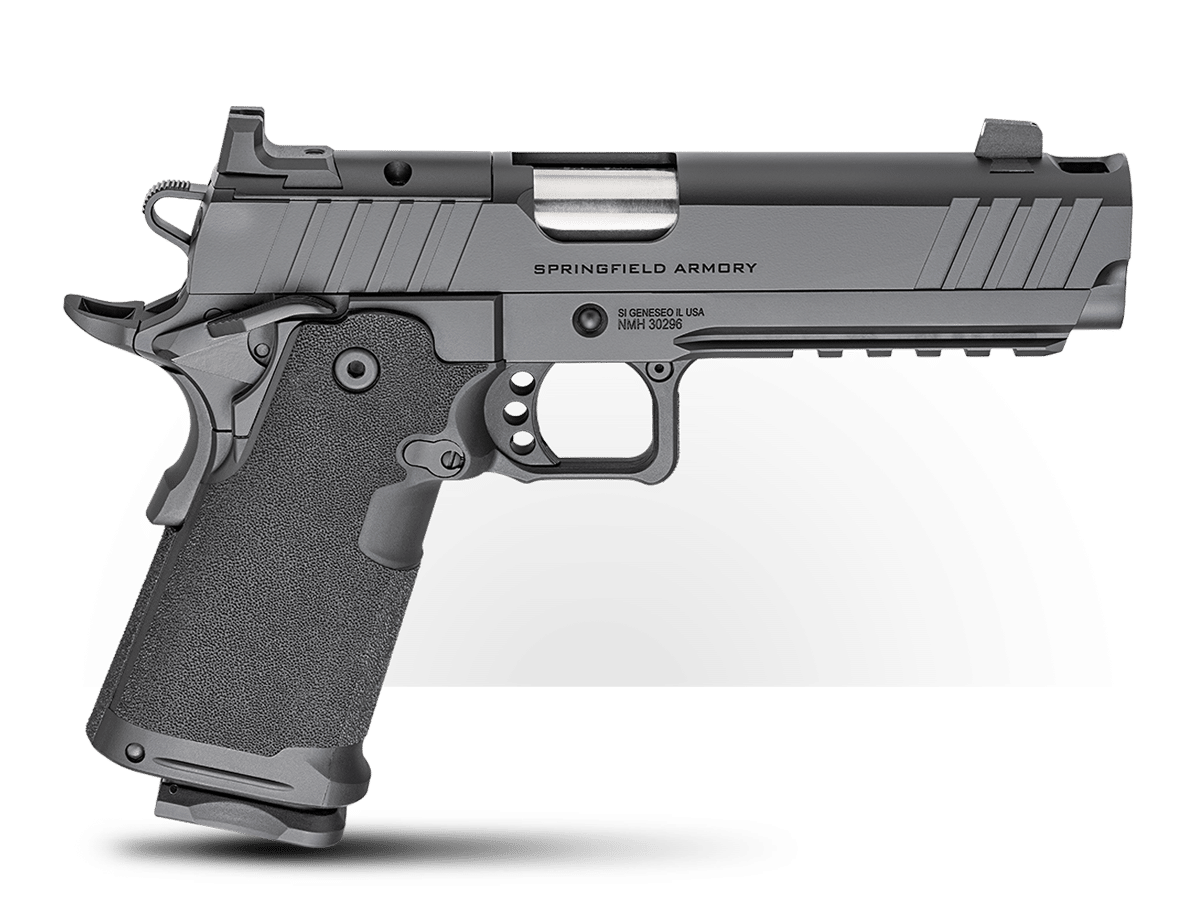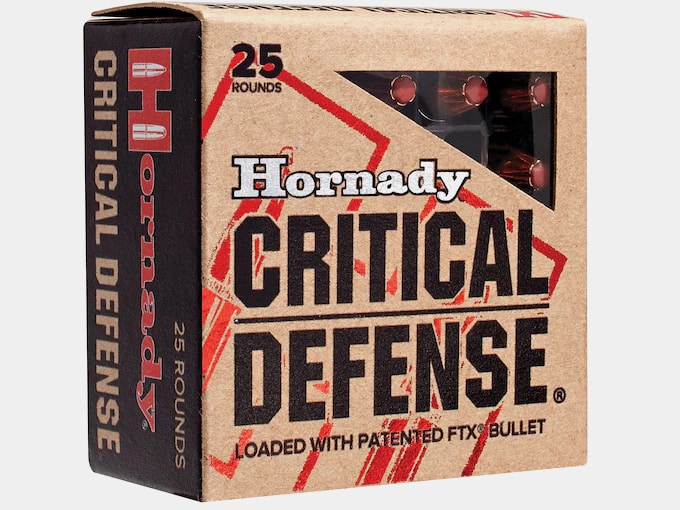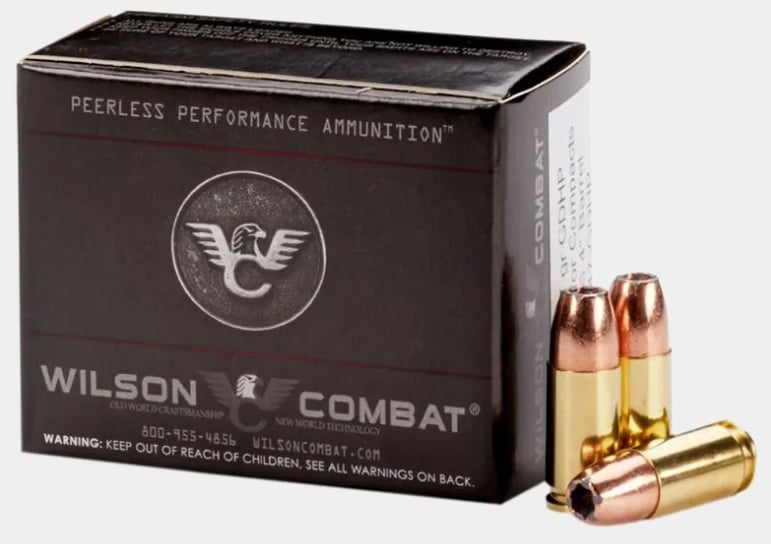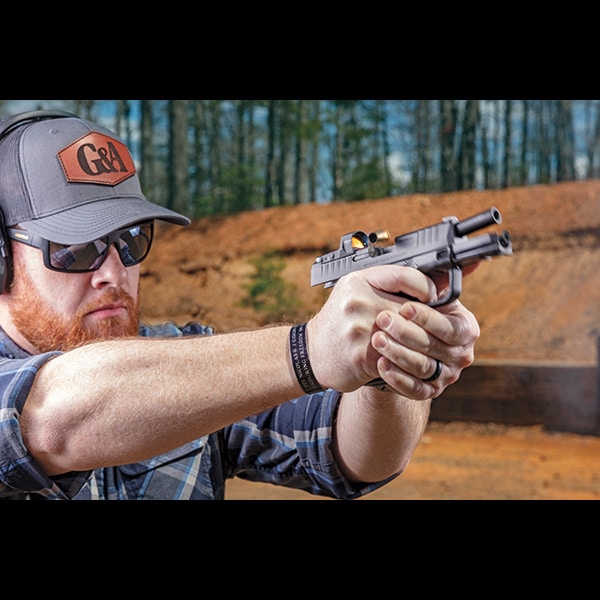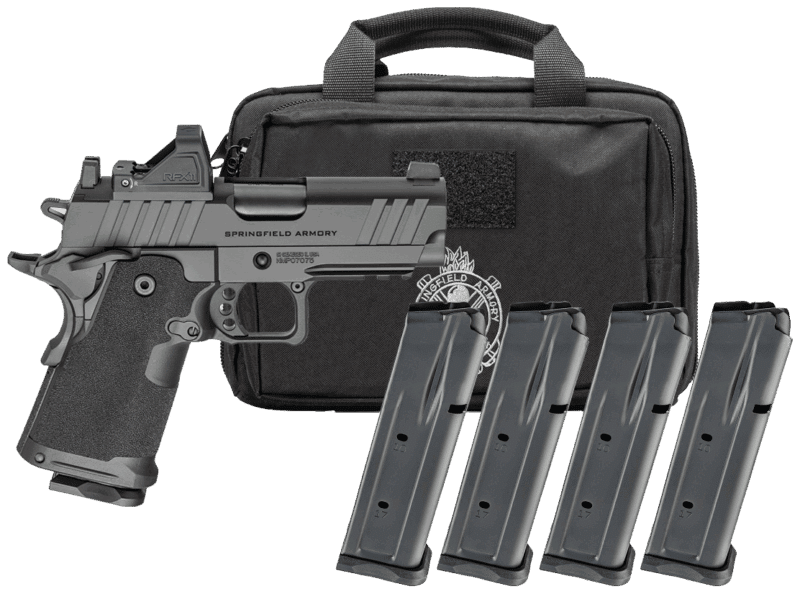Review: 1911 DS Prodigy Comp 9mm
July 30th, 2024
9 minute read
The handgun renaissance continues at Springfield Armory with the introduction of the integrally compensated 1911 DS Prodigy Comp AOS 9mm pistol in both 5” and 4.25” configurations. Even for a professional gun scribe, it can be hard to keep pace with the new models and innovations. Hellcats, and Echelons, and 1911s, oh my!
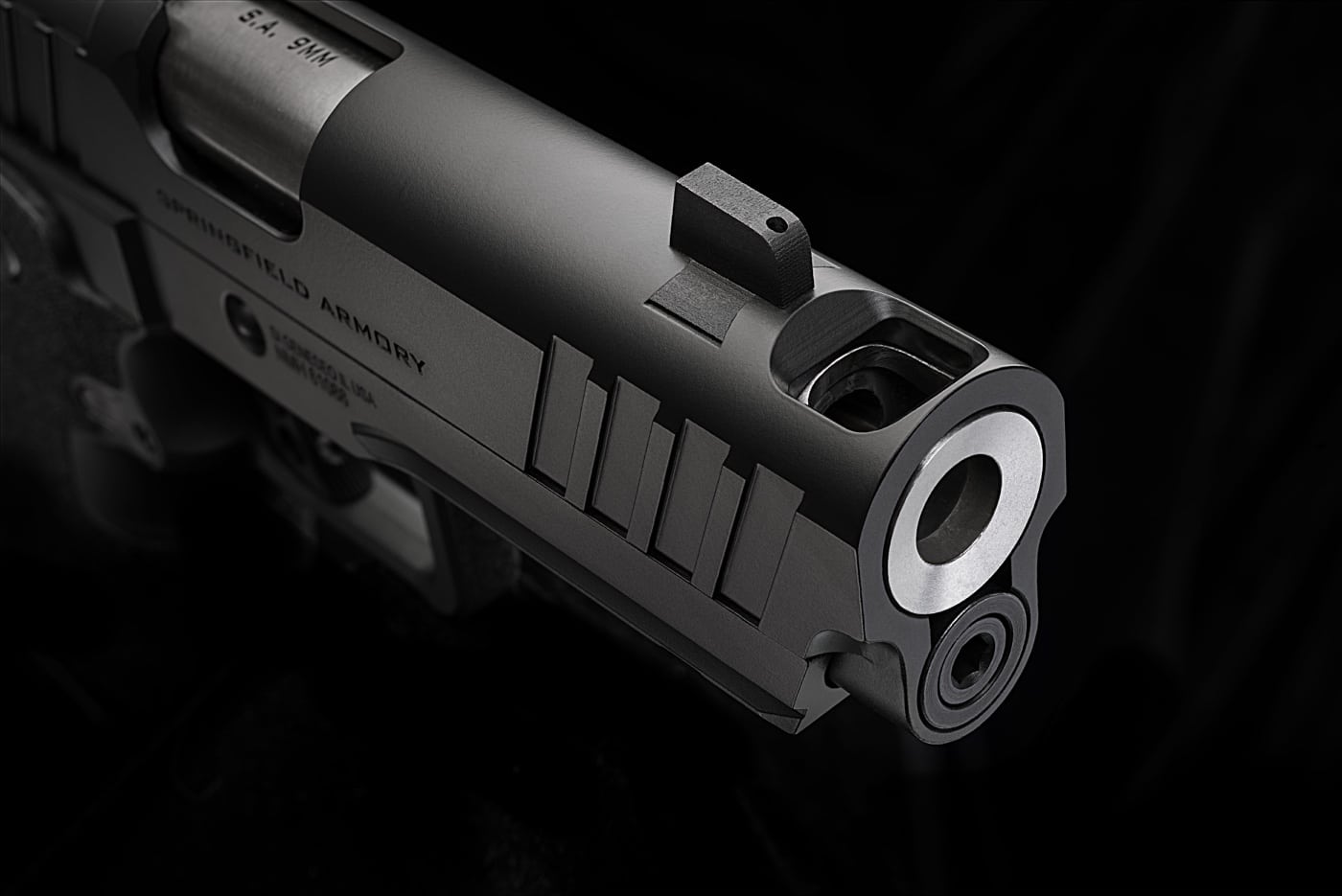
This time around it’s the double-stack 1911-style Prodigy that has garnered engineering’s attention, and the result is a trendy and tangible upgrade.
Prodigiously Ported
Springfield Armory’s 1911 DS Prodigy is a single-action, hammer-fired, semi-automatic pistol. As its designation suggests, the Prodigy shares many features and traits with traditional 1911s, but it eschews the slim frame and single-column magazine for a more voluminous double-stack (DS) design. Chambered for 9mm, Prodigy pistols come with two magazines boasting 17- and 20-round capacities. Although these are the standard payloads for the platform, state-compliant Springfield Prodigy 10 round magazines are also available.
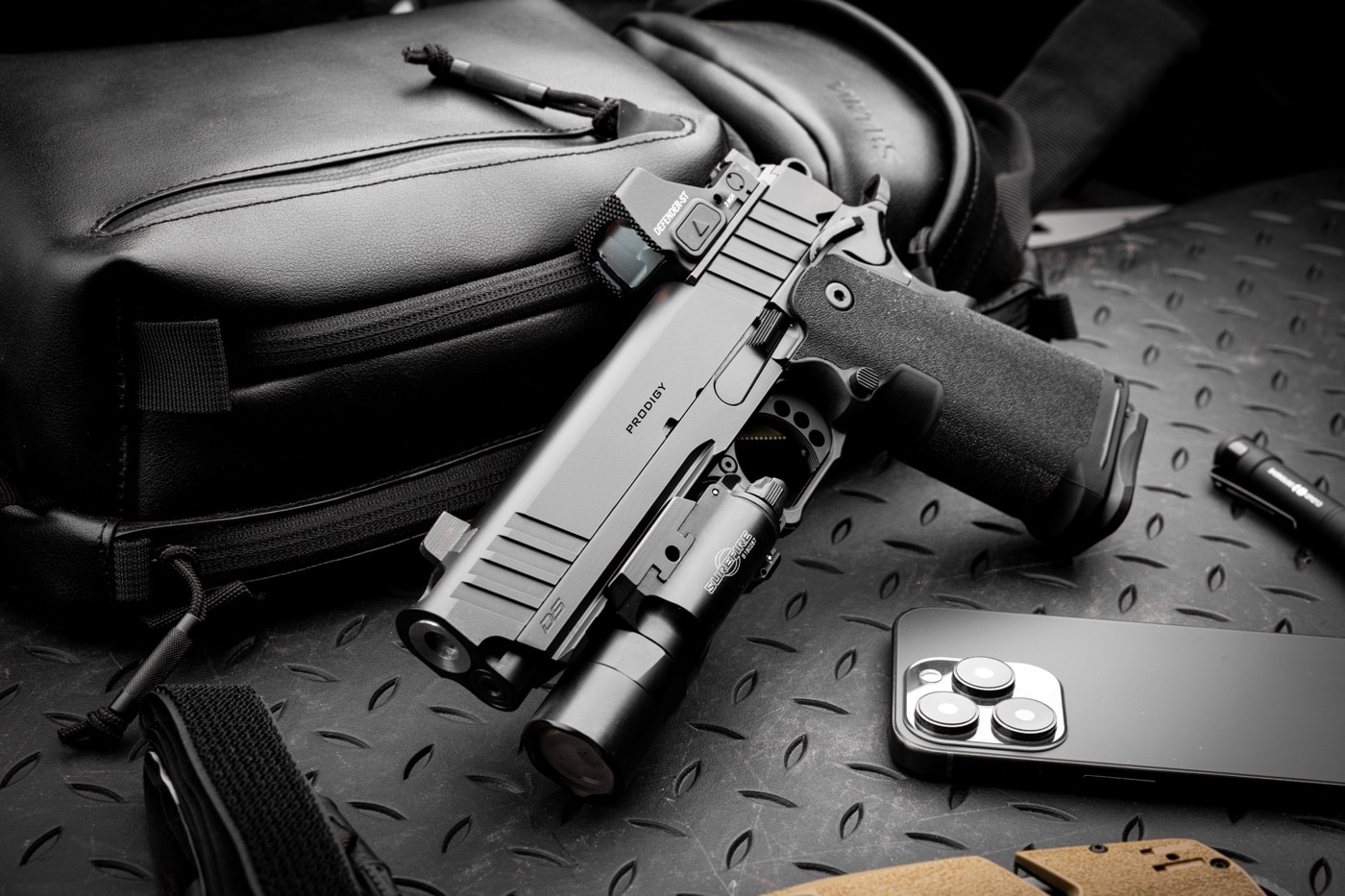
At writing, the pistol’s family tree follows two primary forks, each with several smaller branches. The first differentiator is barrel length, as the Prodigy is offered with either a 5” barrel — and appropriately sized slide — in the standard model or configured for a 4.25” barrel and shortened slide. Regardless of barrel length, additional options include optics-installed configurations, low-capacity models, and, now, guns with integrally compensated barrels and slides.
The primary purpose for adding a compensator to a pistol is recoil mitigation. Compensators, like muzzle brakes, harness the pressurized gases produced by cartridge ignition, and vector it in a useful direction. On a handgun, that direction is typically straight up, and the result is downward pressure that combats muzzle rise during recoil.
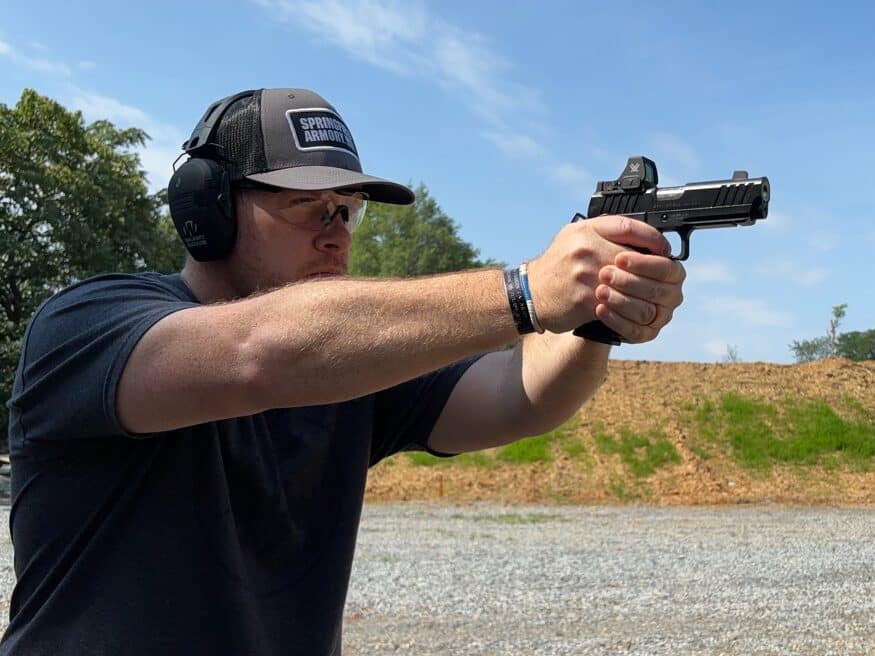
Muzzle rise occurs as the result of energized gas being vented forward and the momentum of the slide’s rearward travel. Those forces combine to lever the pistol over the shooter’s hands, which act like a fulcrum. A compensator, acting like a booster at the front of the gun, helps stabilize the pistol during recoil. Ideally, they reduce disruption to the sight picture, facilitating greater target awareness and fast follow-on shots.
To achieve these benefits, a separate compensator component is often affixed to a lengthened barrel, as Springfield did with its Hellcat RDP pistol. These arrangements work well, but they also change the gun’s external dimensions, meaning essential products such as holsters may be harder to source.
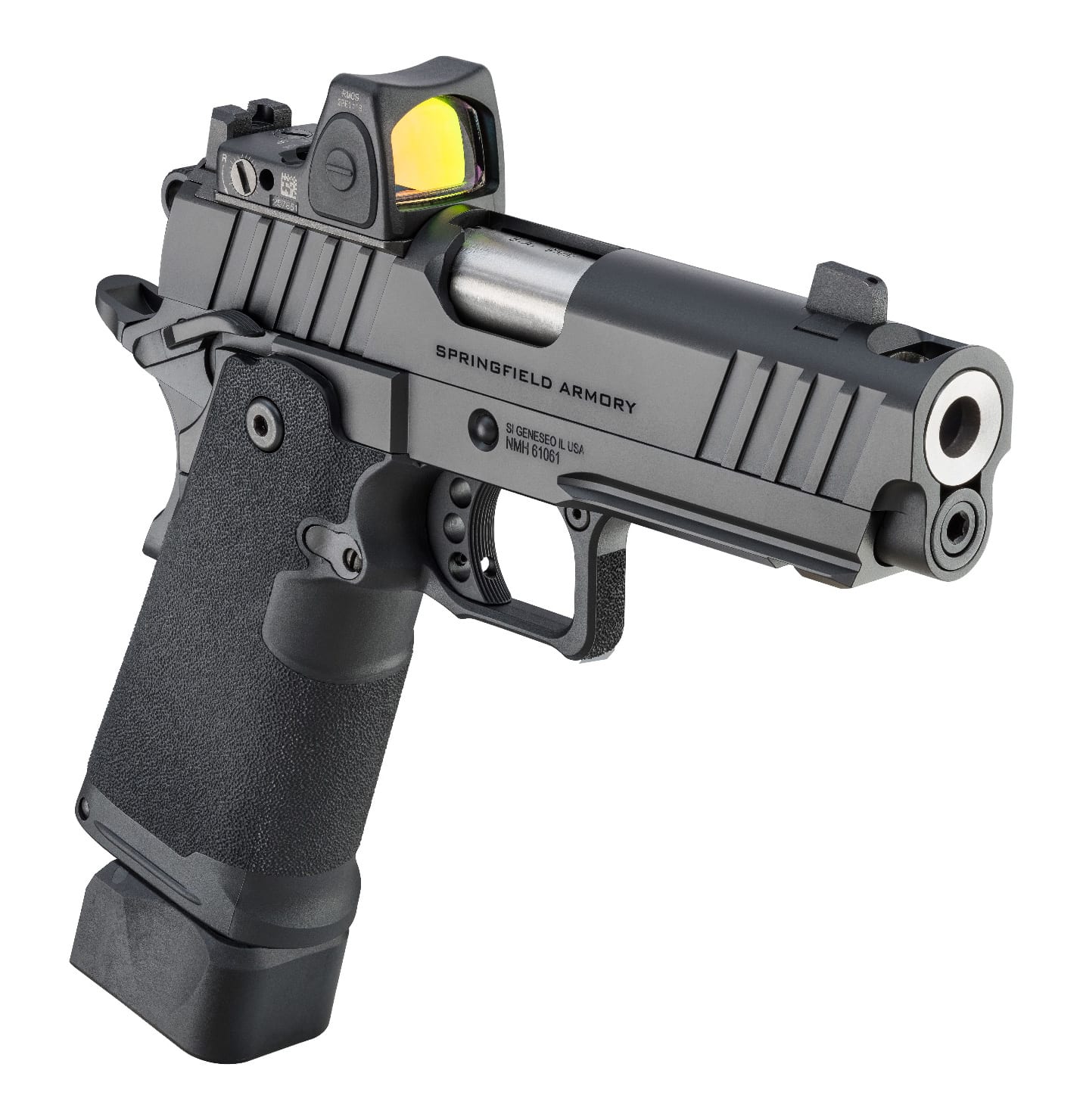
With the Prodigy, the company opted for a more straightforward approach, machining 0.43”x0.33” ports through both the slide and barrel. It’s the same technique Springfield Armory utilized on the recently introduced Hellcat Pro Comp, and it’s brilliant in its simplicity since compensation is achieved without adding parts or changing the gun’s external specs.
One other change distinguishes the Prodigy Comp configurations, and it’s also located near the business-end of the barrel. Whereas the standard sighting configuration for the Prodigy pairs a green fiber optic front sight with a black, serrated, U-notch rear, the Prodigy Comp comes with a white-outlined, tritium-powered front night sight. Experience tells me that the heat-sensitive fiber-optic rod wouldn’t reliably hold up to hot gas being vented up its backside, so Springfield wisely chose a beefier steel component that happily offers improved low-light performance.
Agency Optic System
If handgun compensators are a trendy upgrade these days, accommodations for slide-mounted optics are downright mandatory. In some cases, though, adding sophisticated features is easier said than done, and mounting micro-red-dot optics to 1911-style pistols has remained a challenge for many makers. The 1911’s typically narrow, round-top slide doesn’t lend itself to having a red-dot parking lot machined into it the way a wider, flatter upper assembly might.
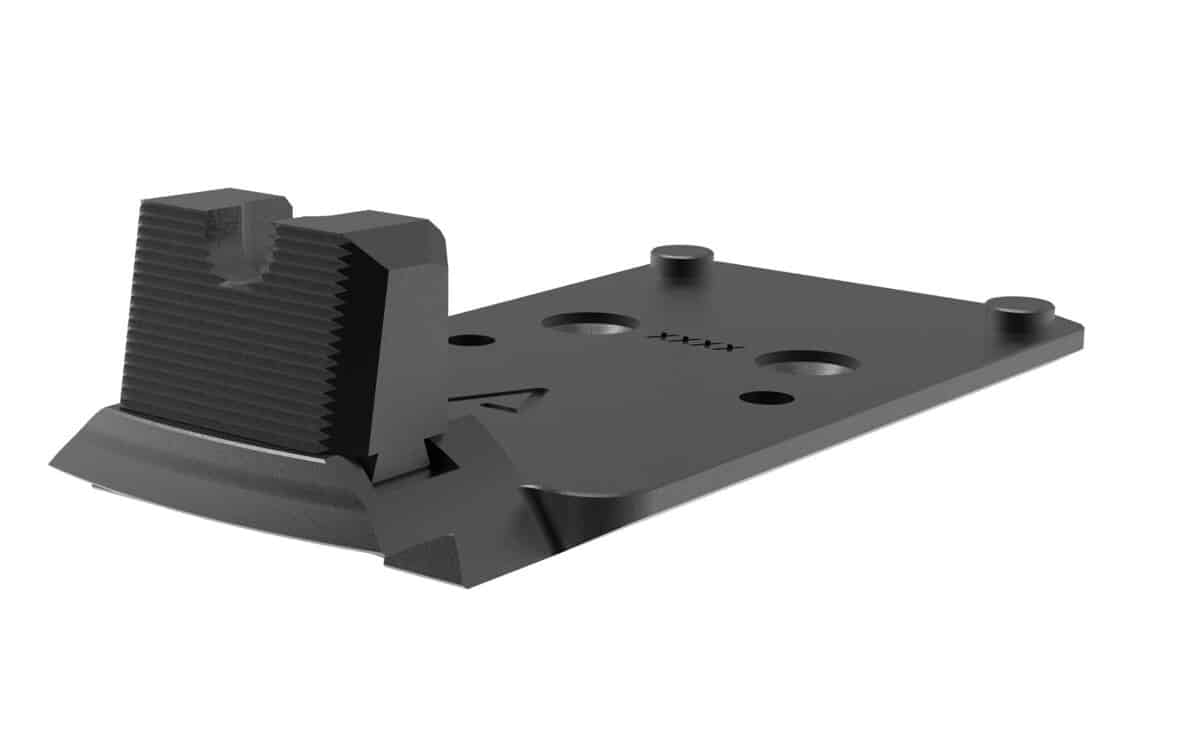
Springfield cracked the code with the Prodigy, though. When the gun was originally launched, one of the headlining features was the Agency Optic System (AOS), a collaborative sight-mounting effort done by Springfield Armory with the custom metal cutters at Agency Arms.
The AOS makes use of high-quality metal plates machined from billet steel. The plates incorporate both a sight-specific mounting footprint and an integrated rear sight. Rather than opting for a one-size-fits-most iron sight solution, AOS rear sights are sized according to the intended optic, ensuring the co-witness through the red dot’s window.
The way it works is quick and intuitive. Two screws hold a cover plate in position on top of the Prodigy’s slide. Removing the cover plate reveals a shallow shelf with screw ports and a tongue-like lug that helps align the cover or mounting plates during installation. The optic mounting plates are affixed to the slide, and the optics, in turn, are secured to the mounting plates. It’s a simple system that is also future proof, since new plates can be designed and manufactured for new optics.
Every Prodigy ships with one AOS plate, designated “A 13B”, and purpose-built for attaching the HEX Dragonfly red dot and similar optics. Additional plates for popular optics are available from the online Springfield Armory Shop.
Vortex Defender-ST
An initial evaluation of the Prodigy Comp would not be complete without testing the AOS system with a red-dot sight. Fortunately, Vortex recently introduced new additions to its Defender line of slide-mounted optics, including the mid-size Defender-ST. The ST model joins the compact Vortex Defender-CCW and upsized Vortex Defender-XL, and serves as a versatile, multipurpose middle ground.
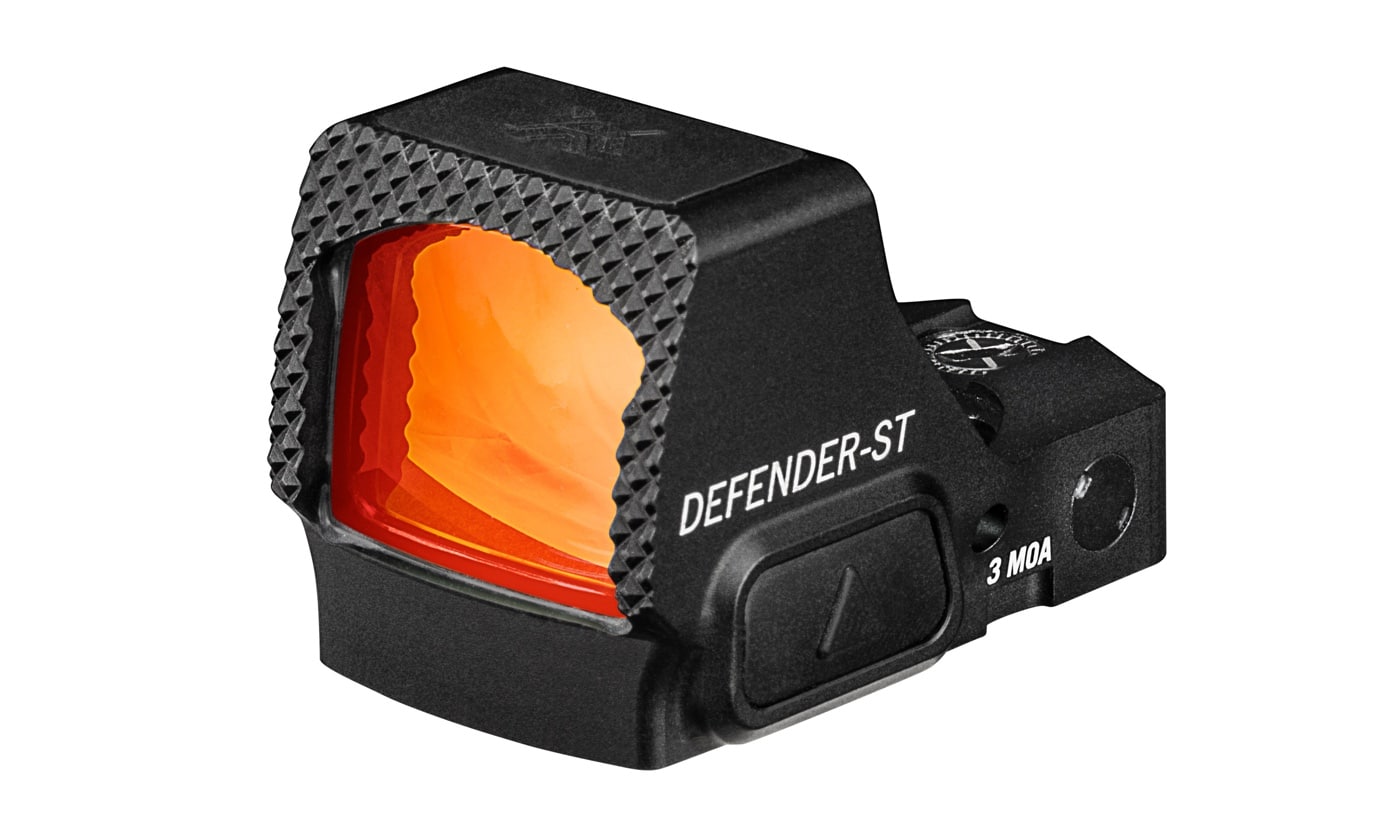
The mounting footprint for the Defender-ST matches the Leupold DeltaPoint Pro pattern, so the “A 15B” AOS plate was a perfect fit. Notable features of the Vortex include the top-load CR2032 battery tray; easy-to-use dual-button controls; durable aluminum housing with full coverage for the large glass lens; 10 reticle brightness settings, including two night-vision-compatible levels; and a motion-activation system that ensures your dot is visible when needed, but saves battery by shutting down after 10 minutes of inactivity. Two size options are available for the Defender-ST’s red-dot reticle, 3 MOA or 6 MOA. Personally, I prefer the finer aiming point, especially for precision firearms like the Prodigy.
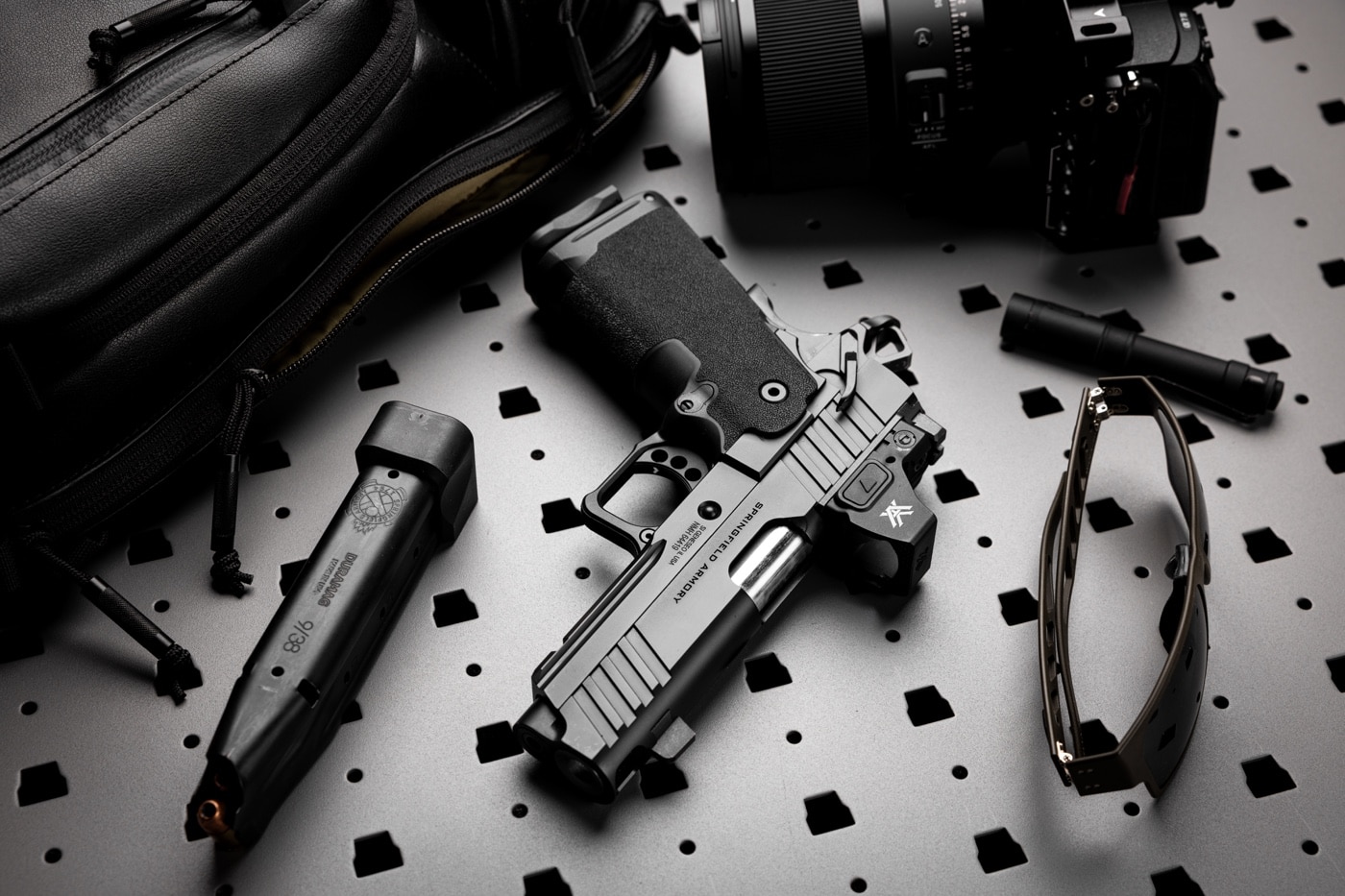
While this was my first time getting hands-on with the Defender-ST, I have been seriously impressed with the Defender-CCW, which is mounted on my every-day-carry Springfield Armory Hellcat Pro. Besides subjecting it to the wear and tear of daily carry, I’ve trained extensively and taken defensive shooting classes with that rig. The optic is righteous, and I expect no less from the Defender-ST. Plus, I love that Vortex includes a wide variety of common mounting screws in clearly labeled baggies with every optic — that is a serious quality-of-life upgrade.
Comp’d & Compact
For the range portion of my evaluation, I opted to test the shorter 1911 DS Prodigy Comp 4.25”. In my previous experience with Prodigy pistols, I really came to appreciate the weight and balance of the smaller gun. Too, the rhythmic cycling in the Prodigy 4.25” just felt “right” and helped me increase the pace of my shooting without sacrificing accuracy. I hoped the Prodigy Comp 4.25” would offer the same or better, and I wasn’t disappointed.
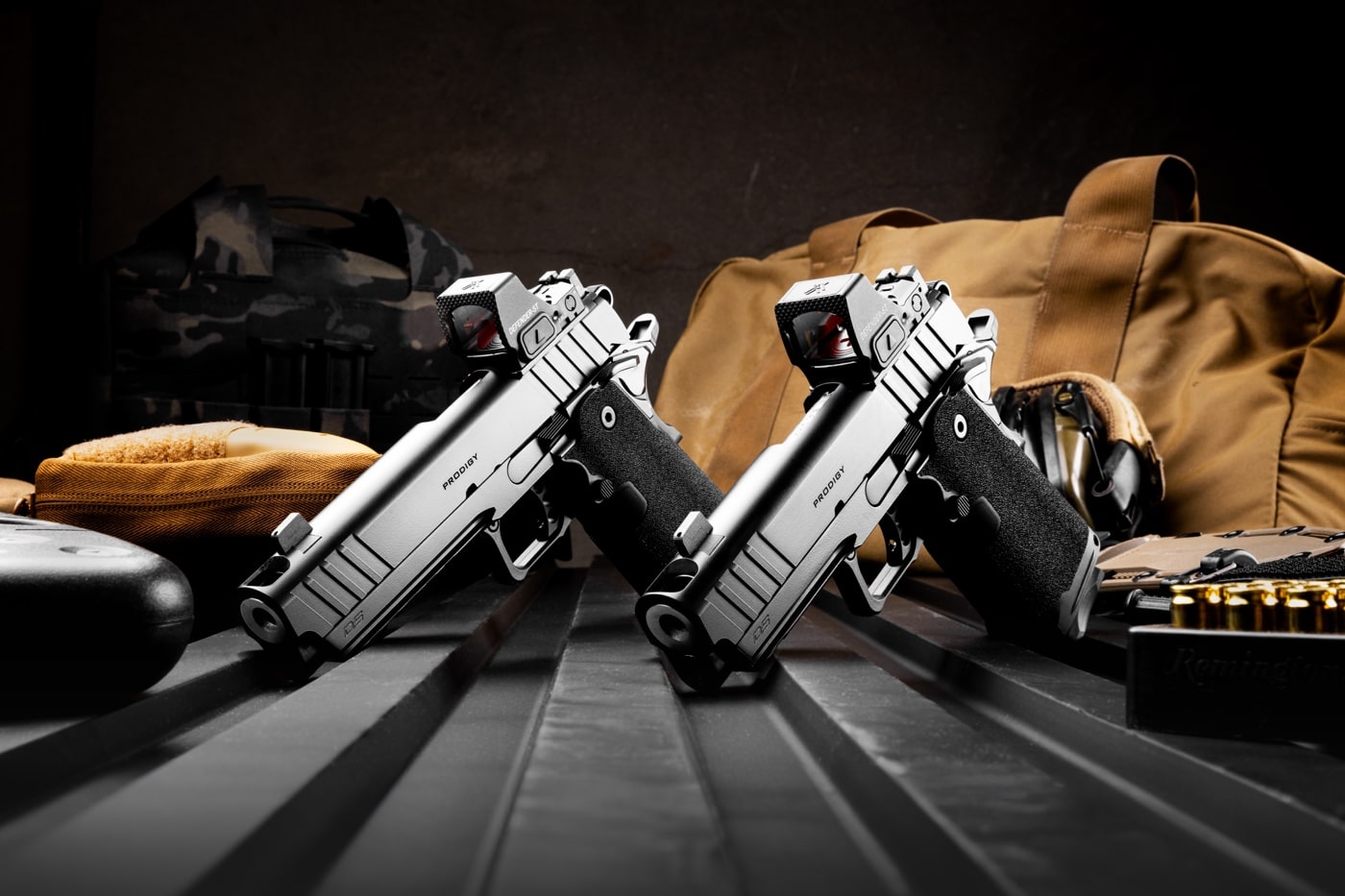
For starters, the weight of the shortened Prodigy is still on-par with an all-steel 1911, despite its polymer frame. True, unloaded, the Prodigy Comp 4.25” tips the scales at around 32 ounces, but add an optic and loaded 17-round magazine, and you quickly catch up to the heft of a full-size .45. Once you get shooting, though, that weight is a benefit, easily soaking up the mild recoil of the 9mm cartridge.
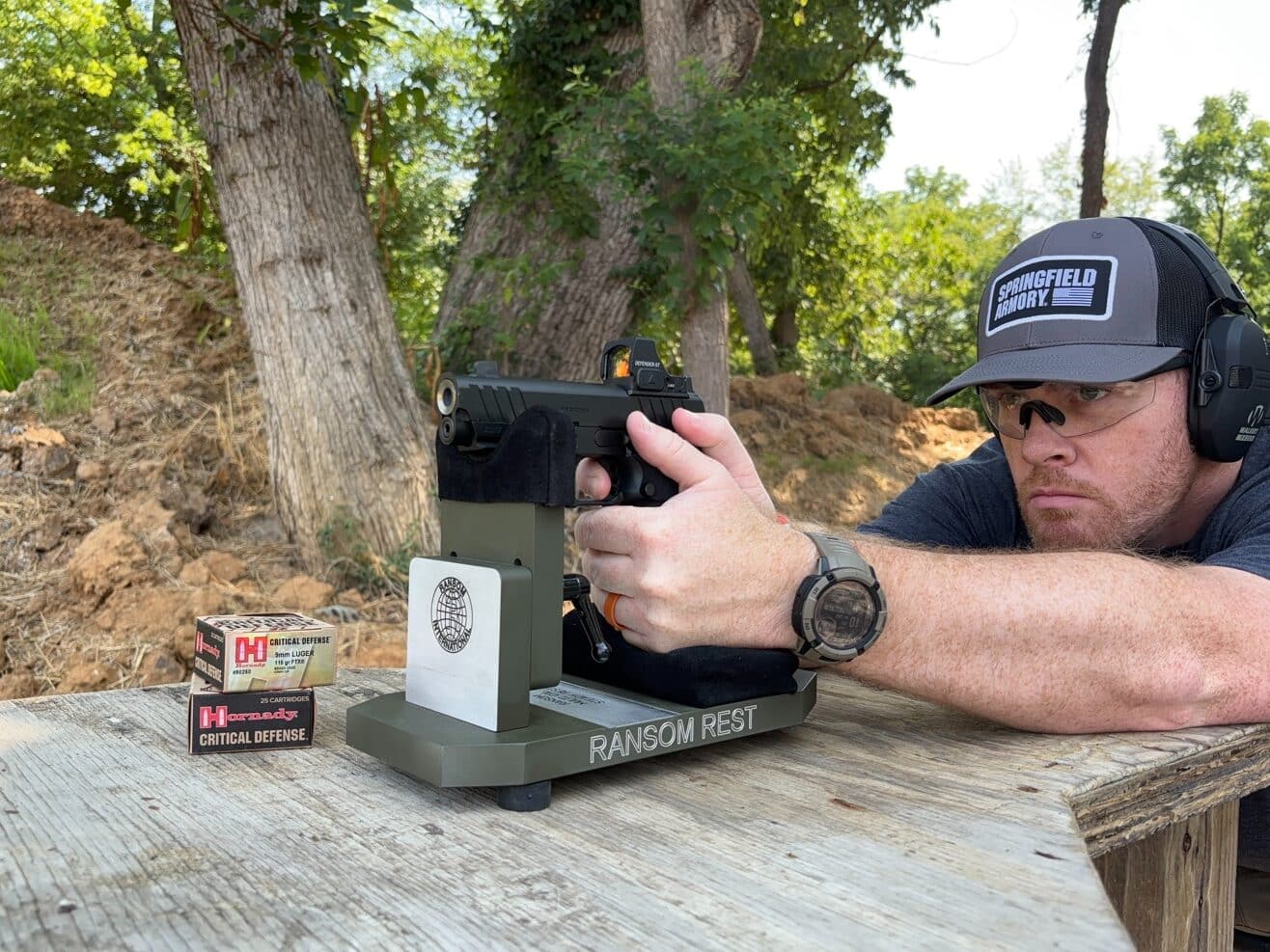
The excellent shooting experience is further enhanced by the new Prodigy’s integral comp. On the range, the pistol shot flat. The usual push or snap of recoil was nigh imperceptible. The compensator helped keep the muzzle down, allowing the slide to cycle smoothly on a near-horizontal plane. When shooting multi-shot strings, I was able to keep the optic within my line of sight, quickly confirm alignment of the reticle on the target, and press out another shot. Firing more than 500 rounds in total, the Prodigy Comp 4.25” functioned flawlessly and shot accurately as the nearby chart will attest.
In addition to its stellar performance, I want to point out that the Prodigy is a gun that’s easy to run. First of all, being a 1911-inspired pistol, the Prodigy is safe, featuring both a rear grip safety and a bilateral manual thumb safety. The thumb safety levers are serrated across their faces for purchase, and snick securely in and out of the downward Fire position.
| Load | Velocity | Best Group | Average Group |
|---|---|---|---|
| Armscor 124-gr. FMJ | 1,092 fps | 1.21″ | 1.38″ |
| Hornady Critical Defense 115-gr. FTX | 1,148 fps | 0.75″ | 0.76″ |
| Wilson Combat 147-gr. GDHP | 1,064 fps | 0.64″ | 0.73″ |
When it’s time to fire, the curved three-hole trigger delivers a clean break. My test sample’s trigger pull weight measured consistently 4 lbs., 10 oz. with a Lyman digital gauge, which is perfect for a defensive firearm.
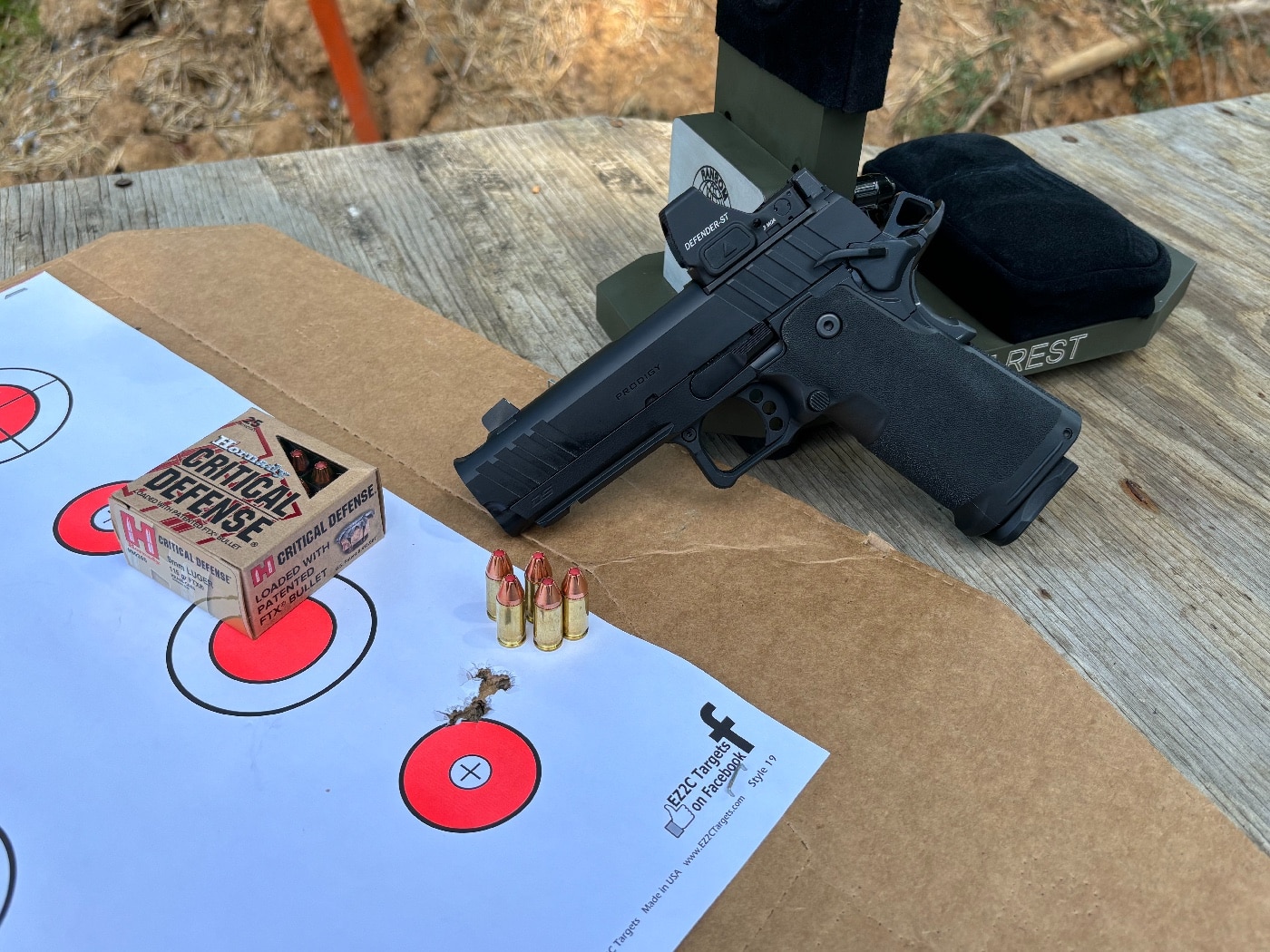
Wide forward and rear cocking serrations also make slide manipulations a breeze, whether running an optic or irons. The forged steel frame, to which the polymer grip module of the pistol is attached, incorporates an accessory mounting rail for adding a light or laser sight. And, finally, the molded polymer grip module offers an aggressive, but not abrasive, texture to facilitate a sure grip, and the magazine well is slightly flared and beveled for quick magazine changes.
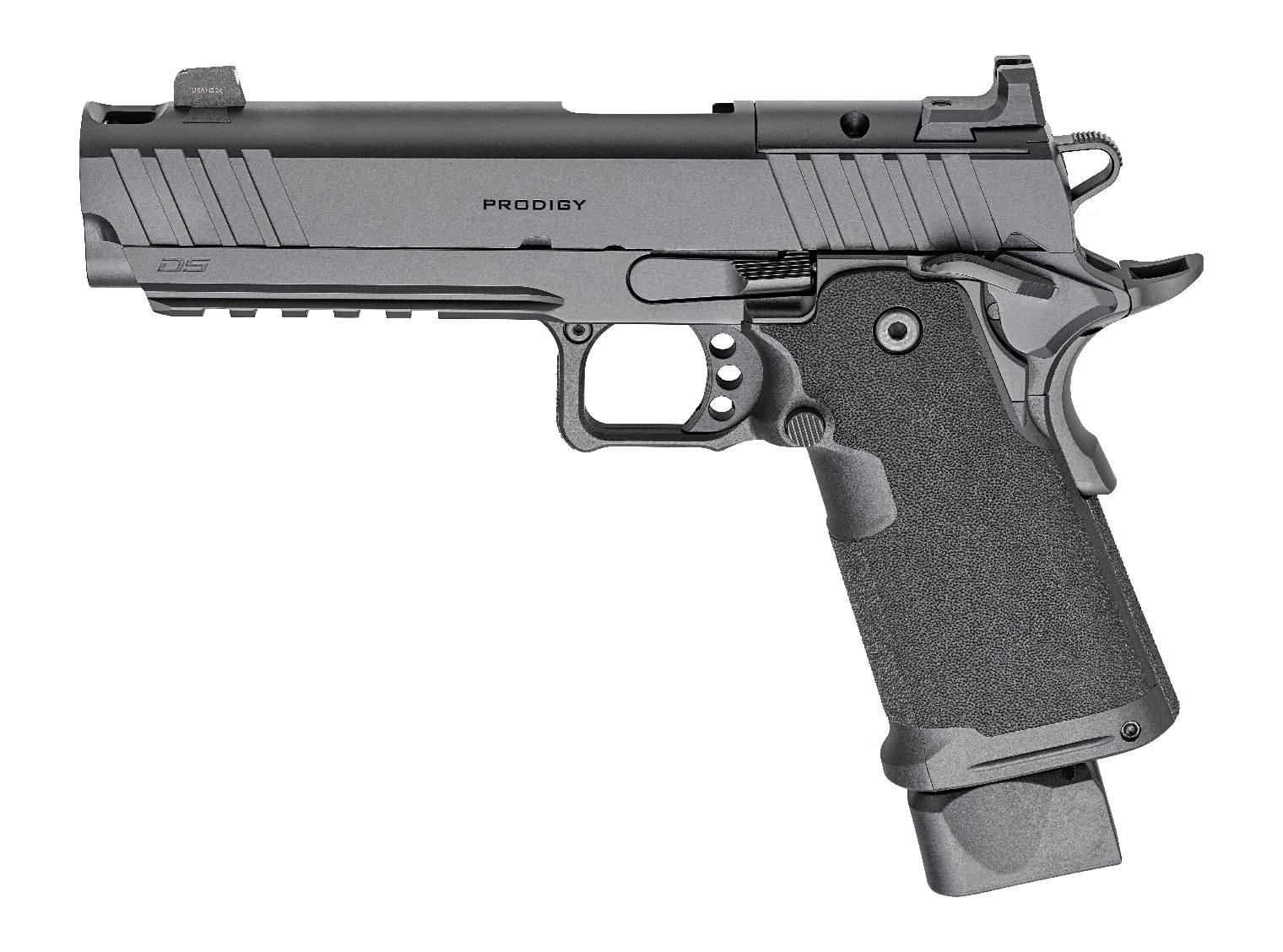
If the Prodigy family has one eccentricity, it is already well-known to seasoned Springfield shooters, and that’s the full-length two-piece guide rod. Nothing to be afraid of here, but be aware that disassembly requires the use of an included 5/32 hex wrench. Read the manual for full instructions and you’ll get the hang of it in no time, but I think it’s prudent to keep that wrench in the range bag, along with tools for mounting and zeroing your optic, and a spare battery. Better to have them and not need them, right?
Specifications
| Chambering | 9mm |
| Barrel | 5”, 4.25” |
| Weight | 33 oz., 32.5 oz. |
| Overall Length | 8.5”, 7.8” |
| Sights | Tritium front, black serrated rear; AOS |
| Grips | Polymer grip module |
| Action | Single-action |
| Finish | Black Cerakote |
| Capacity | 17+1 and 20+1 (one magazine of each type included) |
| MSRP | $1,599 |
Conclusion
In all, the Prodigy Comp proved to be a worthy addition to the Springfield 1911 DS lineup, and the Vortex Defender-ST was a perfect pairing. The gun ran reliably and shot flat enough that I never needed to search for the dot. In its 4.25” configuration, the Prodigy was already one of my favorite handguns for range use and defensive carry. Now, the pistol gets another boost thanks to the new integral comp.
Editor’s Note: Be sure to check out The Armory Life Forum, where you can comment about our daily articles, as well as just talk guns and gear. Click the “Go To Forum Thread” link below to jump in!
Join the Discussion
Featured in this article
Continue Reading
Did you enjoy this article?

 208
208




